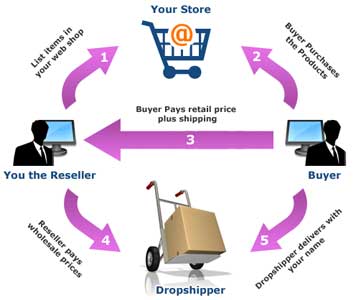Trying to get in the e-commerce business is a tough prospect. With behemoths such as Amazon practically owning the landscape, there are several barriers to entry. Still, the perks of having an online business are tangible—you can work in the comfort of your own home (or practically anywhere, actually), you get to save on location and operational expenses, and you can enjoy the benefits of a completely flexible schedule, not beholden to any boss but your own customers.
One of the biggest problems that online marketplaces face is inventory. Owing to the in-demand nature of online shopping, running out of stock is often catastrophic. It drives potential buyers to other outlets that do have the goods they are looking for.
If you’re an enterprising online business owner or still planning to become one, drop shipping is a viable way to avoid this pressing situation.
Drop Shipping 101: Definition, Process & Advantages
As a drop shipping retailer, you do not have to store your products onsite. Instead, you can rely on a wholesale supplier to deliver the goods directly to your customers.
Once an order has been placed, the buyer contacts the supplier and provides the details for delivery, and the supplier takes care of the rest. With this set up, issues in inventory and fulfilment would be pretty much a thing of the past.
1. It allows you to greatly expand your inventory.
You can sell different kinds of items that may result in storage problems under the traditional system. If you so desired, you’d be able to sell food, electronics, books, lawnmowers, or what have you. Of course, if you wish to sell this wide variety of goods, you’ll need to cultivate an equally varied directory of wholesale suppliers to provide what you require.
2. You won’t need immense capital to start with.
This is primarily because you don’t have inventory or warehouse space to worry about, as well as the personnel and security those entail. This is all covered by your supplier. You’ll be able to focus on the front end of your business— customer service, networking, and marketing. The nature of your “remote warehouses” also means that you’ll be able to deal with orders anywhere there is an Internet connection, ensuring efficiency and timely operations.
Customers don’t need to know you’re drop shipping, as you can have the shipping label mark your business as the return address. In essence, drop shipping is outsourcing your warehouse.
Tools of the Trade
To become a drop shipping retailer, all you really need are things you likely already have.
The logistics end of the system will obviously require a computer connected to the Internet, so you can access your contacts and customers. You also need this hardware to create and maintain your own website store-front, showcasing your catalogue of goods.
A blog will be instrumental in reaching out to potential customers and partners. With your comments section open, it also provides an accessible, human face to your business.
In this modern age where you can pretty much literally get anything and everything you need online, you’ll need to set up a store that appeals to a very specific demographic, with the ideal product line for that particular niche. Make sure that demand exists for your store; otherwise, you’ll just be setting yourself up for financial losses.
A thorough knowledge of the products you’ll be selling is critical. Some examples of products that are always in demand include toys and electronics, especially in countries where import fees are excessive.
When determining the range of products that you intend to drop ship, know which products have rapid turnover. Those kinds of products are unsuitable for drop shipping, because they spend very little time in your inventory anyway. You would want to invest more in items that are infrequently sold, have great profit margins, or are high-risk (e.g. brand new expensive gadgets), since these are more cost-effective to drop ship.
Finding the Right One(s)
There are a few parameters that mark reliable, trustworthy wholesale suppliers:
- In the online sphere, the age of the website is a good indicator of a wholesaler’s credibility. Older, more established suppliers are naturally better, since being in business for a long time indicates success, as well as less chances of fraudulence. However, some of the things you need to be wary of with online wholesalers include random fees, poor customer reviews, and non-existent warranties.
- When looking for wholesalers with brick-and-mortar shops, you can go to trade shows, look them up in trade magazines, or ask for recommendations from people you trust.
Once you’ve settled on a pool of suppliers, you’ll need to manage them. Send bi-weekly checks to stay on top of their inventory, and, if possible, have several suppliers stocking the same item so that your stock would overlap.
You also need to discuss the terms of the return policy. Make sure that the return address contains that of your business and not the supplier’s. On the customer’s end, follow up with satisfaction surveys for you to have other indicators of the effectiveness of your supplier.
Is Drop Shipping For You?
As in all business endeavours the key is conducting ample research before investing your time and money. You’ll need a thorough understanding of your goals and business methods to know whether drop shipping will work for you—just because it was a success in other companies doesn’t mean it will work for everyone.
For our readers out there: did drop shipping work for you? Are there experiences you’d like to share? Please let us know in the comments section below!



CommentLuv vs Disqus – Why I Don’t Use CommentLuv!